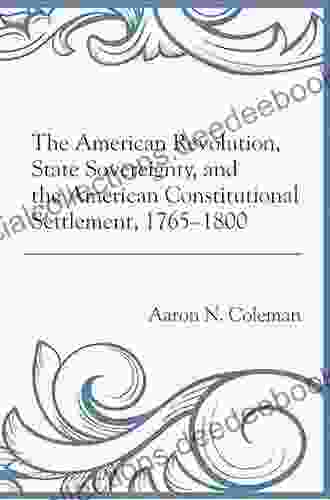The American Revolution, State Sovereignty, and the American Constitution: A Comprehensive Examination of the Historical Roots and Impact on American Governance

5 out of 5
| Language | : | English |
| File size | : | 1733 KB |
| Text-to-Speech | : | Enabled |
| Screen Reader | : | Supported |
| Enhanced typesetting | : | Enabled |
| Word Wise | : | Enabled |
| Print length | : | 273 pages |
The American Revolution, a pivotal event in the annals of world history, not only marked the birth of a new nation but also laid the groundwork for a unique system of government that would profoundly shape the course of American history. This article will explore the intricate relationship between the American Revolution, state sovereignty, and the subsequent development of the American Constitution. We will delve into the historical context, examine key events, and analyze the lasting implications of these interconnected concepts on the foundation and evolution of American governance.
Historical Context
Prior to the American Revolution, the American colonies were governed as separate entities under the authority of the British Crown. Each colony possessed its own legislature and legal system, and there was a significant degree of local autonomy. However, the British government's attempts to assert greater control over the colonies, particularly through taxation and other economic policies, sparked widespread discontent and ultimately led to the outbreak of the Revolution.
One of the underlying principles driving the Revolution was the concept of state sovereignty. The colonists believed that they possessed the inherent right to govern themselves and that the British government had overstepped its authority by imposing laws and regulations without the consent of the colonial legislatures. This belief in state sovereignty was clearly articulated in the Declaration of Independence, which proclaimed that "all men are created equal, that they are endowed by their Creator with certain unalienable Rights, that among these are Life, Liberty and the pursuit of Happiness." The Declaration further asserted that "governments are instituted among Men, deriving their just powers from the consent of the governed."
The Articles of Confederation
In the aftermath of the Revolution, the newly independent states initially struggled to establish a stable and effective national government. Under the Articles of Confederation, ratified in 1781, the states retained their sovereignty and the federal government was given limited powers. The Articles proved to be inadequate, however, as they lacked mechanisms for enforcing laws, regulating commerce, and responding to national emergencies.
The Constitutional Convention
Recognizing the need for a stronger central government, delegates from the states convened in Philadelphia in 1787 to revise the Articles of Confederation. However, the delegates ultimately decided to scrap the Articles and draft a new constitution that would create a more robust and enduring framework for American governance.
The Constitutional Convention was a pivotal moment in American history, and the debates and compromises that took place during the convention shaped the fundamental principles of the American Constitution. One of the key issues debated was the balance between state sovereignty and federal authority. The delegates ultimately agreed on a system of federalism, in which power would be divided between the central government and the states.
Federalism and the American Constitution
Federalism is a system of government in which power is divided between a central government and regional or state governments. In the American context, federalism was designed to preserve the sovereignty of the states while also creating a strong national government capable of addressing matters of national importance.
The American Constitution establishes a framework for federalism by dividing power between the federal government and the states through the Supremacy Clause, the Commerce Clause, and the Necessary and Proper Clause. The Supremacy Clause establishes that the Constitution and federal laws take precedence over state laws. The Commerce Clause gives the federal government the power to regulate interstate commerce. And the Necessary and Proper Clause allows the federal government to enact laws that are necessary and proper to carry out its enumerated powers.
The American Revolution, state sovereignty, and the development of the American Constitution are inextricably linked concepts that have shaped the foundation and evolution of American governance. The belief in state sovereignty, enshrined in the Declaration of Independence, drove the colonists to seek independence from British rule. The Articles of Confederation, while initially an attempt to preserve state sovereignty, proved inadequate to meet the challenges of nationhood. And the Constitutional Convention, through a series of compromises and debates, forged a system of federalism that balanced state sovereignty with the need for a strong national government.
The American Constitution, ratified in 1788, has served as the supreme law of the land for over two centuries. It has weathered countless challenges and adaptations, and its principles of federalism, separation of powers, and individual rights continue to guide the American experiment in self-governance.
5 out of 5
| Language | : | English |
| File size | : | 1733 KB |
| Text-to-Speech | : | Enabled |
| Screen Reader | : | Supported |
| Enhanced typesetting | : | Enabled |
| Word Wise | : | Enabled |
| Print length | : | 273 pages |
Do you want to contribute by writing guest posts on this blog?
Please contact us and send us a resume of previous articles that you have written.
 Page
Page Text
Text Story
Story Reader
Reader Library
Library Paperback
Paperback Magazine
Magazine Bookmark
Bookmark Bibliography
Bibliography Foreword
Foreword Preface
Preface Synopsis
Synopsis Annotation
Annotation Scroll
Scroll Codex
Codex Tome
Tome Classics
Classics Library card
Library card Biography
Biography Autobiography
Autobiography Memoir
Memoir Reference
Reference Encyclopedia
Encyclopedia Resolution
Resolution Librarian
Librarian Catalog
Catalog Card Catalog
Card Catalog Borrowing
Borrowing Stacks
Stacks Lending
Lending Academic
Academic Journals
Journals Rare Books
Rare Books Special Collections
Special Collections Interlibrary
Interlibrary Literacy
Literacy Thesis
Thesis Dissertation
Dissertation Book Club
Book Club Theory
Theory Guido Parietti
Guido Parietti Tom Hoffman
Tom Hoffman Manuel Pastor
Manuel Pastor Mckenzie Wark
Mckenzie Wark Briallen Hopper
Briallen Hopper Erik O Ronningen
Erik O Ronningen Rick Perry
Rick Perry Edwin Black
Edwin Black Todd Kettler
Todd Kettler David Blum
David Blum James Kirkpatrick
James Kirkpatrick Shaun Teka Joyner
Shaun Teka Joyner Lauren Elliott
Lauren Elliott Karl Christ
Karl Christ Caryn Lee
Caryn Lee Dannielle Blumenthal
Dannielle Blumenthal Cynthia Guill
Cynthia Guill Glenway Wescott
Glenway Wescott James Buice
James Buice Christian Jenkner
Christian Jenkner
Light bulbAdvertise smarter! Our strategic ad space ensures maximum exposure. Reserve your spot today!
 Cason CoxFollow ·12.8k
Cason CoxFollow ·12.8k Stan WardFollow ·15.9k
Stan WardFollow ·15.9k Gabriel MistralFollow ·4k
Gabriel MistralFollow ·4k Ralph Waldo EmersonFollow ·10.5k
Ralph Waldo EmersonFollow ·10.5k Beau CarterFollow ·2.6k
Beau CarterFollow ·2.6k Yasushi InoueFollow ·18.4k
Yasushi InoueFollow ·18.4k Matthew WardFollow ·13k
Matthew WardFollow ·13k Branden SimmonsFollow ·14.4k
Branden SimmonsFollow ·14.4k

 Andy Hayes
Andy HayesEmbracing Now: Embark on a Mindfulness Journey for a...
In a world...

 Heath Powell
Heath Powell100 Hymns for Violin and Guitar: A Comprehensive Guide to...
The violin and...

 Floyd Richardson
Floyd RichardsonBark In The Park: Poems For Dog Lovers
Dogs are our best...

 Douglas Adams
Douglas AdamsThe Barter Crusade: A Journey into the Realm of Exchange...
In a world driven by monetary transactions,...

 Nathaniel Hawthorne
Nathaniel HawthorneInsight Guides Explore Nice & the French Riviera...
Prepare to embark on an unforgettable journey...

 Carlos Fuentes
Carlos FuentesThe Ultimate Practical Guide to Percussion: Exploring the...
Embark on a journey into the enchanting...
5 out of 5
| Language | : | English |
| File size | : | 1733 KB |
| Text-to-Speech | : | Enabled |
| Screen Reader | : | Supported |
| Enhanced typesetting | : | Enabled |
| Word Wise | : | Enabled |
| Print length | : | 273 pages |












